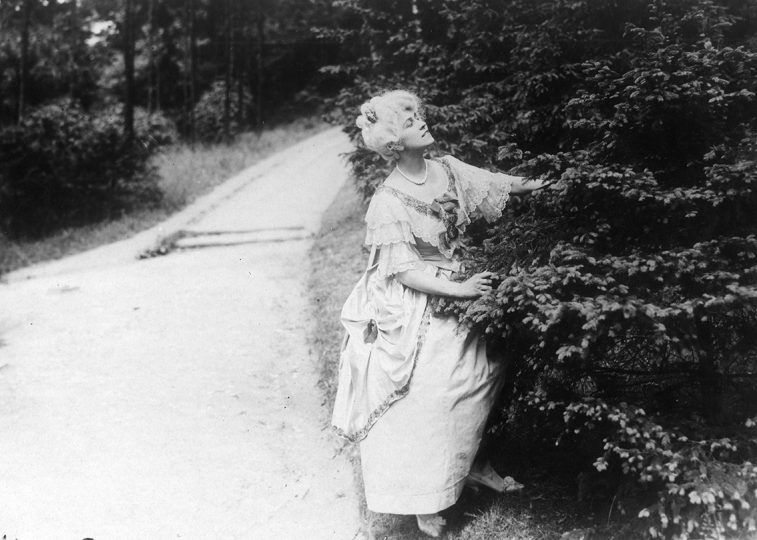“Actor and director, Satyr (Kozlonoh, 1918) and co-director, The Oriental Languages’ Teacher (Učitel orientálních jazyků, 1918).”[1] This is a brief entry in the encyclopaedia Kdo byl kdo v československém filmu před r. 1945 (Who was Who in Czechoslovak Film Before 1945) introducing Olga Rautenkranzová. Was her contribution to early Czech film culture so inconsequential that she didn’t deserve a more extensive entry? Or did the author simply not manage to find more information?
Other publications describing the beginnings of film in our country are equally laconic. It is therefore not easy to properly appreciate Rautenkranzová’s significance in Czech cinema. We could speculate as to whether it was due to the artistic quality of her two films (at least one of them is interesting thanks to its staging of actors in space)[2] or whether it was due to a general marginalisation of female contribution to certain arts.
For various sociocultural reasons limiting the possibilities of female work and expression, there are indisputable cases in history when the female contribution was and has been limited and ignored. Rautenkranzová’s films also are considered in the context of filmographies of her co-authors, Karel Degl and Jan S. Kolár, instead of for instance being a follow-up to the previous artistic endeavours of a woman considered to be the first Czech female film director.
Olga Rautenkranzová was born on 22nd September 1891 in Prague. The date of her death is unknown. Just like Andula Sedláčková and Olga Scheinpflugová, she studied acting under the tutelage of Marie Hübnerová, a renowned personality from the National Theatre in Prague. After her studies, Rautenkranzová performed as an actress and dancer in the National Theatres in Prague and Brno. Her roles included both ballet and drama.
Within the usual framework of the period production, the formation of our film industry seems primarily like a male affair. Women are predominantly connected to acting. In reality, they held a significant portion of creative and executive positions, and just like men, they co-decided what the viewers could see and where.
Zorka Janovská, Marie Karenová and Hana Temná authored or co-authored librettos to many silent films. Karolína Kalousová and Marie Umhöhová were among the first to hold a cinema licence in our country. Many women ran travelling cinemas and founded the first film rentals. The leading star of Wetebfilm, Suzanne Marwille, worked in the company also as a producer, dramaturge, screenwriter and artistic director.
It can also be assumed that Andula Sedláčková, as the co-founder of ASUM, co-created her own celebrity image. Thea Červenková founded her own film company, and her career is the best proof that female authorship in early cinema cannot be limited only to “screenwriter” and “director.”
Before the industrialisation of film, individual creative professions intertwined, and working in the industry often meant holding many different positions and influencing several different levels of film poetics and production simultaneously. Cinema – as a modern invention – reflected, or possibly supported, a far-reaching social transformation manifested among other things in a higher number of women in creative and executive positions.
For instance, in the United States, early film production followed the theatre model. Men and women held different positions, and instead of a hierarchical division of labour, they strived for equality. Cinema became masculinised after its industrialisation and the inflow of capital connected to it.
It was only after this reconfiguration that women were rendered a minority in an inferior position. But a gender-oriented research of the early history of Czech film, which would enable an evaluation of the situation here, still hasn’t been conducted.
But as is apparent from a thorough analysis of the performances in The Oriental Languages’ Teacher by Radomír D. Kokeš, Olga Rautenkranzová’s contribution to the final film wasn’t limited only to directing. The film benefited a lot from her theatre experience, which was praised by Jan S. Kolár in his memoirs stored in the Collection of Sound Recordings of the Czech National Film Archive.
Her theatre experience seems to be the most probable explanation why she was asked by Lucernafilm, shortly before the split of Austria-Hungary, to direct the one-reeler Satyr written by Quido Maria Vyskočil. In this costume Rococo-style romance with a simple archetypical story, a statue of a jealous satyr is brought to life and threatens the a young couple’s love.
The exterior scenes were shot in the Grébovka park in Prague. The film’s DoP was the experienced cinematographer Karel Degl from the newly established company Bratři Deglové, who also distributed the film. Rautenkranzová played the leading female role of the countess’ daughter. Her partner was played by Oldřich Knímek, who would later become a director. Before distributing Satyr into the cinemas, Lucernafilm entrusted Rautenkranzová with directing another film.
The contemporary comedy The Oriental Languages’ Teacher is based on a story by Jan S. Kolár. In it, a daughter of a marquise falls in love with her teacher of Turkish, but her father doesn’t approve. The film was shot mainly in studios and partly outside at the Lucerna Palace terrace.
While reminiscing about the production, Kolár spoke about Rautenkranzová as an “intelligent lady,” but also suggested that as an inexperienced director, she didn’t have a clue and that it was he and cinematographer Karel Degl who did most of the work.
Kolár also offered an explanation as to why Rautenkranzová wasn’t successful in the industry. She allegedly didn’t have Suzanne Marwille’s ardour or Anna Ondráková’s sweetness and came to the decision that cinema wasn’t a path she should follow.
This assumption implying that women need more than just talent to break through doesn’t explain why Rautenkranzová retired from the public sphere after finishing the abovementioned film and why there are virtually no records of her subsequent activities and personal life.
Notes:
[1] Jiří Havelka, Kdo byl kdo v československém filmu před r. 1945. Prague: Čs. filmový ústav 1979, p. 211.
[2] See Radomír D. Kokeš, Filmové herectví, česká němá kinematografie a otázky studia stylu. Iluminace 30, 2018, no. 2, pp. 31–57.

